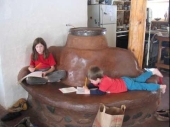
















Dabumb wrote:
I found some firebrick from an ole chimney that was demolished. It's the red clay bricks. Does anyone know if they will work for a rocket mass heater like this one.








http://metropioneer.com




Need more info?
Ernie and Erica
Wood burning stoves, Rocket Mass Heaters, DIY,
Stove plans, Boat plans, General permiculture information, Arts and crafts, Fire science, Find it at www.ernieanderica.info








Projects, plans, resources - now on the Permies.com digital marketplace.
Try the Everything Combo as a reference guide.




Dabumb wrote:
Quick question. Should I use regular mortar for my firebrick, or Refractory cement? Seams I"v read where people have used both so I"ll ask the experts. Thanks.
I'll try to post a pic or 2 soon as I begin my project.
Projects, plans, resources - now on the Permies.com digital marketplace.
Try the Everything Combo as a reference guide.

|
My, my, aren't you a big fella. Here, have a tiny ad:
Rocket Mass Heater Jamboree And Updates
https://permies.com/t/170234/Rocket-Mass-Heater-Jamboree-Updates
|




